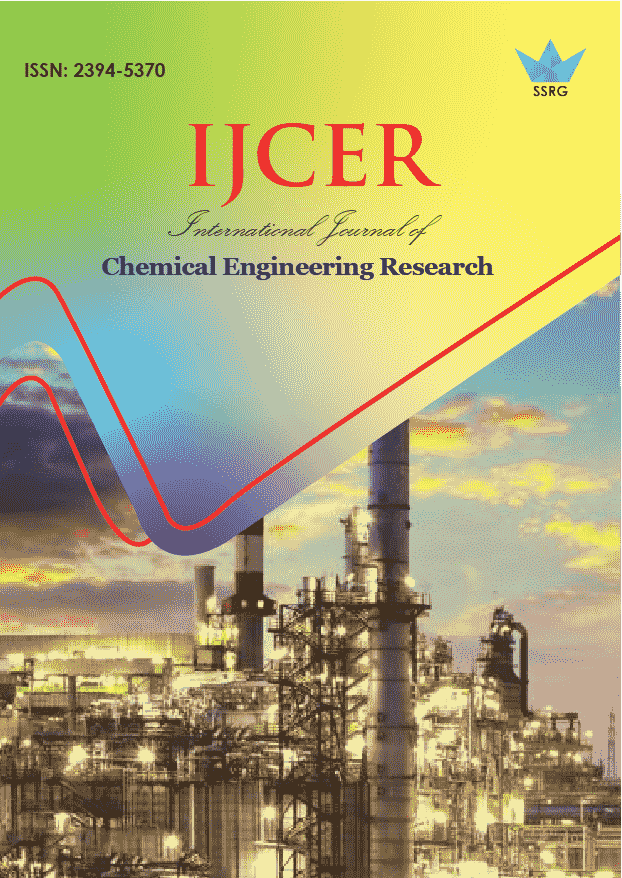Effectiveness of Sand Filtration and Activated Carbon in Oilfield Wastewater Treatment

| International Journal of Chemical Engineering Research |
| © 2020 by SSRG - IJCER Journal |
| Volume 7 Issue 2 |
| Year of Publication : 2020 |
| Authors : Stanley E. Ngene, Kiran Tota-Maharaj |
How to Cite?
Stanley E. Ngene, Kiran Tota-Maharaj, "Effectiveness of Sand Filtration and Activated Carbon in Oilfield Wastewater Treatment," SSRG International Journal of Chemical Engineering Research, vol. 7, no. 2, pp. 13-23, 2020. Crossref, https://doi.org/10.14445/23945370/IJCER-V7I2P102
Abstract:
The design and installation of produced water treatment plant in oil and gas production facility involves the expenditure of high capital cost. This cost has been a limiting factor for most small indigenous oil and gas production operation especially those that require to meet only oil-in-water regulatory limit of 30ppm before disposal; this is the situation in the case study facility. In view of this gap, it becomes necessary to design a process which may either be incorporated into the existing plant or installed separately at minimum cost to ensure the produced water are treated to meet regulatory requirement for disposal of produced water without incurring heavy capital cost. This work, a part of an on-going research on the application of environmental process engineering for pollutants reduction and energy savings in crude oil production processes, is designed to help operators meet regulatory limit for disposal of produced water without heavy capital investment. Although the result of this work will increase the profitability of crude oil and natural gas production process, it is limited to treatment of produced water for disposal for small scale production and may not be employed for produced water treatment above 5,000 barrels of liquid per day is required.
Keywords:
Produced water, oil-in-water, regulatory limit, hydrocarbon, adsorption.
References:
[1] J. A. Veil, M. G. Puder, D. Elcock, and R. J. A. Redweik, Jr., “A White Paper Describing Produced Water from Production of Crude Oil, Natural Gas and Coal Bed Methane”. Chicago, USA: US Department of Energy-National Energy Technology Laboratory, 2004.
[2] S. F. J. Vegueria, J. M. Godoy, and N. Miekeley, “Environmental impact studies of barium and radium discharges by produced waters from the “Bacia de Campos” Oilfield offshore platforms, Brazil”, Journal of Environmental Radioactivity., vol. 62, pp. 29-38, 2002. http://dx.doi.org/10.1016/S0265-931X(01)00148-5
[3] Ibid [1]
[4] J. Neff, K. Lee, and E. M. DeBlois, “Produced Water: Overview of Composition, Fates, and Effects”. In: K. Lee, and J. Neff, Ed. Produced Water. New York, USA: Springer, 2011.
[5] X. J. Zhang, W. Ji, and B. H. Wang, “Study on the Treatment Technology of Oilfield Produced Water,” Journal of Industrial Safety and Environmental Protection, vol. 33, issue 4, pp. 13-16, 2007.
[6] OGP - International Association of Oil and Gas Producers, “Fate and effects of naturally occurring substances in produced water on marine environment” OGP, London, Uinted Kingdom. Report n. 364, 2005. Available: http://www.ogp.org.uk/pubs/364.pdf. Accessed on: 14 December 2019.
[7] J. M. Neff, “Effects of contaminants from oil well produced water,” Journal of Bioaccumulation in Marine organisms, vol. 2002, pp. 1-35, 2007. https;//doi.org/10.1016/B978-008043716-3/50002-6
[8] J. Pichtel, “Oil and Gas Production Wastewater: Soil Contamination and Pollution Prevention”, Applied and Environmental Soil Science, vol. 2016 pp. 1-24, 2016. https://doi.org/10.1155/2016/2707989.
[9] X. Liu, “Research Progress on Treatment of Produced Water by Adsorption Method”, IOP Conference Series: Materials Science and Engineering, vol. 472 No. 1, 2019. doi:10.1088/1757-899X/472/1/012082
[10] E. T. Igunnu, and G. Z. Chen, “Produced water treatment technologies”, International Journal of Low-Carbon Technologies, vol. 9, Issue 3, pp. 157-177, September 2014. https://doi.org/10.1093/ijlct/cts049
[11] D. T. Meijer, and C. Madin, “Removal of dissolved and dispersed hydrocarbons from oil and gas produced water with Macro Porous Polymer Extraction technology to reduce toxicity and allow water use”, APPEA Journal pp. 1-12, March 2010.
[12] A. S. Nwosi-Anele, and O. O. Iledare, “Produced Water Treatment Methods and regulations; Lessons from the Gulf of Mexico and North Sea for Nigeria”, American Journal of Engineering Research (AJER), vol. 5 issue 12 pp.46-57, 2016.
[13] USEPA - United States Environmental Protection Agency., Oil and Gas Extraction Point Source Category (Part 435), 40 CFR, Fed. Reg. 29, 294-344, 2007. Available at: http://www3.epa.gov. Accessed on: 14 December 2019.
[14] Ibid [12].
[15] P. Kundu, and I. Mishra, “Treatment and reclamation of hydrocarbon-bearing oily wastewater as a hazardous pollutant by different processes and technologies: a state-of-the-art review”. Reviews in Chemical Engineering, vol. 35, issue 1, pp. 73-108, 2018. doi:10.1515/revce-2017-0025
[16] T. C. M Nonato, A. A. De A. Alves, M. L. Sens et al., “Produced water from oil - A review of the main treatment technologies”, Journal of Environmental Toxicology, vol. 2, issue 1, pp. 23-7, 2018.
[17] C. Geankoplis, Transport Process and separation Process Principles, 4th ed, USA: Prentice Hall, p. 904, 2003.
[18] M. S. Zipf, I. G. Pinheiro, and M. G. Conegero, “Simplified greywater treatment systems: Slow filters of sand and slate waste followed by granular activated carbon”, Journal of Environmental Management, vol. 176, pp. 119-1271, 2016. http://dx.doi.org/10.1016/j.jenvman.2016.03.035
[19] L. Latrach, N. Ouazzani, T. Masunaga, A. Hejjaj, K. Bouhoum, M. Mahi, and L. Mandi, “Domestic wastewater
disinfection by combined treatment using multi-soil-layering system and sand filters (MSL–SF): A laboratory pilot study” Ecological Engineering, vol. 91, pp. 294-301, 2016. http://dx.doi.org/10.1016/j.ecoleng.2016.02.036
[20] G. Crini, E. Lichtfouse, L. Wilson, and N. Morin-Crini, “Adsorption-oriented processes using conventional and non-conventional adsorbents for wastewater treatment: Green Adsorbents for Pollutant Removal”, Springer Nature, vol. 18, pp.23-71, 2018,
[21] K. S. Knaebel, “For your next separation consider adsorption”, Chem Eng. vol. 102 issue 11, pp. 92-102, 1995.
[22] W. J. Weber, and B. M. Van-Vliet, “Synthetic adsorbents and activated carbon for water treatment: Overview and experimental comparisons”, J Am Water Works Assoc., vol. 73 issue 8 pp. 420-6, 1981.
[23] A. O. Adeleke, A. A. A. Latiff, A. A. Al-Ghethi, and Z. Daud, “Optimisation of Operating Parameters of novel composite adsorbent for organic pollutant removal from POME using response surface methodology”, Chemosphere, vol. 174, pp. 232-242, 2017.

 10.14445/23945370/IJCER-V7I2P102
10.14445/23945370/IJCER-V7I2P102